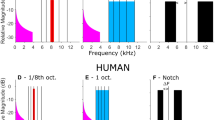Summary
The five waves comprising the averaged neural response (cochlear audiometry or electrocochleogram) to click acoustic stimuli were recorded with pinna and scalp electrodes in both human and animal subjects. The latencies and waveform of the waves in the cat were similar to those recorded in human subjects. Recordings in the cat with pinna-scalp electrodes simultaneously with intracranial recordings from auditory nuclei in the same animal, lead to the following conclusions concerning the sources of these waves in cats and probably in man also: 1. the first response wave is generated by the first order cochlear nerve fibers; 2. the second wave is generated mainly in the cochlear nucleus; 3. the third wave is generated in the superior olivary complex; 4. the fourth and fifth waves are generated in the inferior colliculus. Thus, this recording system provides a convenient means of measuring the neural activity of the cochlea, the brain stem auditory nuclei and the cerebral cortex in human subjects.
Zusammenfassung
Ableitungen der gemittelten neuralen Potentiale der menschlichen Cochlea auf “Klick-Reizung” mit Elektroden am Ohrläppchen und Vertex (Electro-Cochleogram oder Cochleare Audiometrie) ergeben einen Wellenkomplex aus 5 Komponenten.
Mit der gleichen Elektrodenanordnung konnte auch bei der Katze eine ebenfalls 5wellige Antwort auf Klick-Reizung erhalten werden.
Dieselbe Elektrodenanordnung ermöglicht auch die Erfassung der Hirnrinden-Antwort auf akustische Reize (Evoked Response Audiometry).
Registriert man die extracraniale Antwort simultan mit der elektrischen Antwort aus intracraniell eingepflanzten Elektroden der Cochlea, von der Fenestra rotunda, so erscheint die erste Welle des Antwortkomplexes gleichzeitig mit dem Aktionspotential der Cochlea (N 1), die zweite gleichzeitig mit derjenigen bei direkter Ableitung vom Nucleus cochlearis. Der dritten Welle im Komplex entspricht eine Antwort, die vom Nucleus olivarius superior abzuleiten ist. Gleichzeitig mit der vierten and fünften Welle des Antwortkomplexes erscheint eine Antwort, die wir vom Colliculus inferior ableiten konnten.
Similar content being viewed by others
References
Bickford, R. G., Jacobson, J. L., Cody, D. T. R.: Nature of average evoked potentials to sound and other stimuli in man. In: Sensory evoked response in man. R. Katzman, ed. Ann. N. Y. Acad. Sci. 112, 204–218 (1964).
Bullock, T. H., Grinnell, A. D., Kezono, I. E., Kameda, K., Katsuki, Y., Nomoto, M., Sato, 0., Suga, N., Yanagisawa, K.: Electrophysiological studies of central auditory mechanisms in cetaceans. Z. vergl. Physiol. 59, 117–156 (1968).
Grinnell, A. D.: The neurophysiology of audition in bats: intensity and frequency parameters. J. Physiol. (Lond.) 167, 38–66 (1966).
Jewett, D. L.: Volume-conducted potentials in response to auditory stimuli as detected by averaging in the cat. Electroenceph. clin. Neurophysiol. 28, 609–618 (1970).
— Romano, M. N., Williston, J. S.: Human auditory evoked potentials: Possible brain stem components detected on the scalp. Science 167, 1517–1518 (1970).
Mast, T. E.: Short-latency human evoked responses to clicks. J. appl. Physiol. 20, 725–730 (1965).
Portmann, M., Aran, J. M., LeBert, G.: Electro-Cochleogramme humain on dehors de toute intervention chirurgicale. Acta oto-laryng. (Stockh.) 65, 105–114 (1968).
Rosenzweig, M. R.: Representation of the two ears at the auditory cortex. Amer. J. Physiol. 167, 147–158 (1951).
Sohmer, H., Feinmesser, M.: Cochlear action potentials recorded from the external ear in man. Ann. Otol. (St. Louis) 76, 427–436 (1967).
—, —: Cochlear and cortical audiometry conveniently recorded in the same subject. Israel J. med. Sci. 6, 219–223 (1970).
—, —, Bauberger-Tell, L., Lev, A., David, S.: Routine use of cochlear audiometry in infants with uncertain diagnosis. Ann. Otol. (St. Louis) 81, 72–75 (1972).
Author information
Authors and Affiliations
Additional information
This study serves as partial fulfillment of the requirements of the Hebrew University-Hadassah Medical School, in Jerusalem toward the M.D. degree of A.L.
This study was supported in part by a grant from the Joint Research Fund of the Hebrew University-Hadassah Medical School.
Rights and permissions
About this article
Cite this article
Lev, A., Sohmer, H. Sources of averaged neural responses recorded in animal and human subjects during cochlear audiometry (Electro-Cochleogram). Arch. klin. exp. Ohr.-, Nas.- u. Kehlk.Heilk. 201, 79–90 (1972). https://doi.org/10.1007/BF00341066
Received:
Issue Date:
DOI: https://doi.org/10.1007/BF00341066




